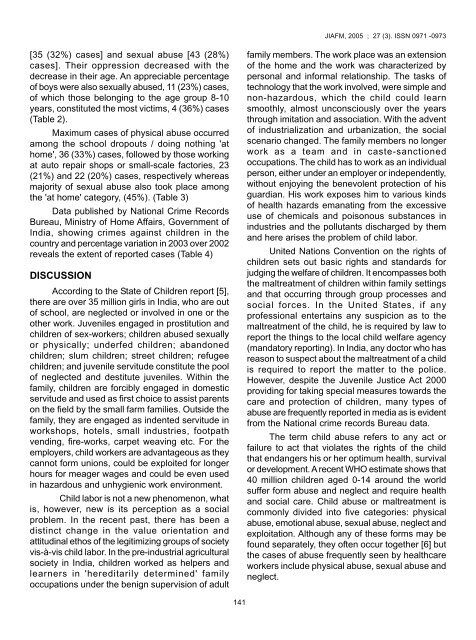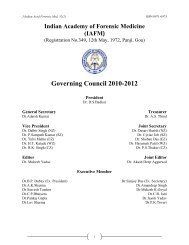violation of children's rights: can forensic medicine help?
violation of children's rights: can forensic medicine help?
violation of children's rights: can forensic medicine help?
You also want an ePaper? Increase the reach of your titles
YUMPU automatically turns print PDFs into web optimized ePapers that Google loves.
JIAFM, 2005 ; 27 (3). ISSN 0971 -0973<br />
[35 (32%) cases] and sexual abuse [43 (28%)<br />
cases]. Their oppression decreased with the<br />
decrease in their age. An appreciable percentage<br />
<strong>of</strong> boys were also sexually abused, 11 (23%) cases,<br />
<strong>of</strong> which those belonging to the age group 8-10<br />
years, constituted the most victims, 4 (36%) cases<br />
(Table 2).<br />
Maximum cases <strong>of</strong> physical abuse occurred<br />
among the school dropouts / doing nothing 'at<br />
home', 36 (33%) cases, followed by those working<br />
at auto repair shops or small-scale factories, 23<br />
(21%) and 22 (20%) cases, respectively whereas<br />
majority <strong>of</strong> sexual abuse also took place among<br />
the 'at home' category, (45%). (Table 3)<br />
Data published by National Crime Records<br />
Bureau, Ministry <strong>of</strong> Home Affairs, Government <strong>of</strong><br />
India, showing crimes against children in the<br />
country and percentage variation in 2003 over 2002<br />
reveals the extent <strong>of</strong> reported cases (Table 4)<br />
DISCUSSION<br />
According to the State <strong>of</strong> Children report [5],<br />
there are over 35 million girls in India, who are out<br />
<strong>of</strong> school, are neglected or involved in one or the<br />
other work. Juveniles engaged in prostitution and<br />
children <strong>of</strong> sex-workers; children abused sexually<br />
or physically; underfed children; abandoned<br />
children; slum children; street children; refugee<br />
children; and juvenile servitude constitute the pool<br />
<strong>of</strong> neglected and destitute juveniles. Within the<br />
family, children are forcibly engaged in domestic<br />
servitude and used as first choice to assist parents<br />
on the field by the small farm families. Outside the<br />
family, they are engaged as indented servitude in<br />
workshops, hotels, small industries, footpath<br />
vending, fire-works, carpet weaving etc. For the<br />
employers, child workers are advantageous as they<br />
<strong>can</strong>not form unions, could be exploited for longer<br />
hours for meager wages and could be even used<br />
in hazardous and unhygienic work environment.<br />
Child labor is not a new phenomenon, what<br />
is, however, new is its perception as a social<br />
problem. In the recent past, there has been a<br />
distinct change in the value orientation and<br />
attitudinal ethos <strong>of</strong> the legitimizing groups <strong>of</strong> society<br />
vis-à-vis child labor. In the pre-industrial agricultural<br />
society in India, children worked as <strong>help</strong>ers and<br />
learners in 'hereditarily determined' family<br />
occupations under the benign supervision <strong>of</strong> adult<br />
family members. The work place was an extension<br />
<strong>of</strong> the home and the work was characterized by<br />
personal and informal relationship. The tasks <strong>of</strong><br />
technology that the work involved, were simple and<br />
non-hazardous, which the child could learn<br />
smoothly, almost unconsciously over the years<br />
through imitation and association. With the advent<br />
<strong>of</strong> industrialization and urbanization, the social<br />
scenario changed. The family members no longer<br />
work as a team and in caste-sanctioned<br />
occupations. The child has to work as an individual<br />
person, either under an employer or independently,<br />
without enjoying the benevolent protection <strong>of</strong> his<br />
guardian. His work exposes him to various kinds<br />
<strong>of</strong> health hazards emanating from the excessive<br />
use <strong>of</strong> chemicals and poisonous substances in<br />
industries and the pollutants discharged by them<br />
and here arises the problem <strong>of</strong> child labor.<br />
United Nations Convention on the <strong>rights</strong> <strong>of</strong><br />
children sets out basic <strong>rights</strong> and standards for<br />
judging the welfare <strong>of</strong> children. It encompasses both<br />
the maltreatment <strong>of</strong> children within family settings<br />
and that occurring through group processes and<br />
social forces. In the United States, if any<br />
pr<strong>of</strong>essional entertains any suspicion as to the<br />
maltreatment <strong>of</strong> the child, he is required by law to<br />
report the things to the local child welfare agency<br />
(mandatory reporting). In India, any doctor who has<br />
reason to suspect about the maltreatment <strong>of</strong> a child<br />
is required to report the matter to the police.<br />
However, despite the Juvenile Justice Act 2000<br />
providing for taking special measures towards the<br />
care and protection <strong>of</strong> children, many types <strong>of</strong><br />
abuse are frequently reported in media as is evident<br />
from the National crime records Bureau data.<br />
The term child abuse refers to any act or<br />
failure to act that violates the <strong>rights</strong> <strong>of</strong> the child<br />
that endangers his or her optimum health, survival<br />
or development. A recent WHO estimate shows that<br />
40 million children aged 0-14 around the world<br />
suffer form abuse and neglect and require health<br />
and social care. Child abuse or maltreatment is<br />
commonly divided into five categories: physical<br />
abuse, emotional abuse, sexual abuse, neglect and<br />
exploitation. Although any <strong>of</strong> these forms may be<br />
found separately, they <strong>of</strong>ten occur together [6] but<br />
the cases <strong>of</strong> abuse frequently seen by healthcare<br />
workers include physical abuse, sexual abuse and<br />
neglect.<br />
141




![syllabus in forensic medicine for m.b.b.s. students in india [pdf]](https://img.yumpu.com/48405011/1/190x245/syllabus-in-forensic-medicine-for-mbbs-students-in-india-pdf.jpg?quality=85)



![SPOTTING IN FORENSIC MEDICINE [pdf]](https://img.yumpu.com/45856557/1/190x245/spotting-in-forensic-medicine-pdf.jpg?quality=85)

![JAFM-33-2, April-June, 2011 [PDF] - forensic medicine](https://img.yumpu.com/43461356/1/190x245/jafm-33-2-april-june-2011-pdf-forensic-medicine.jpg?quality=85)


![JIAFM-33-4, October-December, 2011 [PDF] - forensic medicine](https://img.yumpu.com/31013278/1/190x245/jiafm-33-4-october-december-2011-pdf-forensic-medicine.jpg?quality=85)


